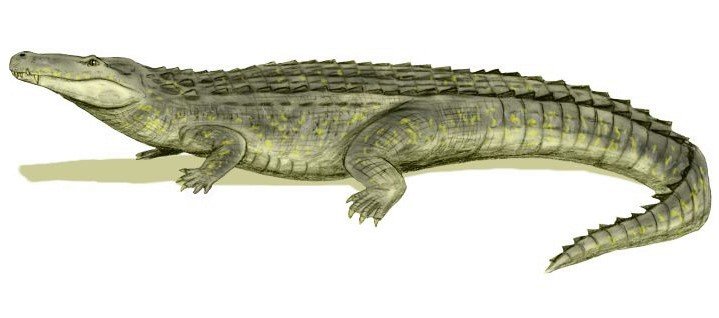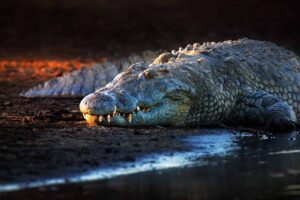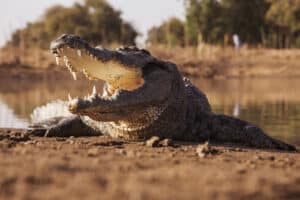The sheer savagery of the modern-day food chain may sometimes leave one wondering what things would have looked like millions of years back. To get an idea of what it was like, we go back to about eight million years ago — to the Miocene Epoch. The geologic record shows that this was a period of massive terrestrial and aquatic life diversity. Just like today, the planet’s ecosystem had massive animals preying on smaller ones, with even bigger ones preying on them as well. However, one of the masters of the food chain back in the Miocene was an 8.4-ton gator, one of the largest of its kind, the Purussaurus.
What Did the Purussaurus Look Like?

The crocodilian order, which includes modern-day crocodiles, alligators, and caimans, had massive monsters millions of years ago. Purussaurus was one of the largest of them all. If modern crocodiles were apex predators today, one can only imagine how a 40-foot version of them would have dominated their home ecosystem.
This 8.4-ton gator dominated South America during the Miocene Epoch and was able to tackle and take down some of the largest prey animals at the time. Purussaurus is rated as one of the largest crocodilians to exist alongside others like the Deinosuchus, Sarcosucus, and Rhamphosuchus. Sarcosuchus and Deinosuchus had a similar size to Purussaurus, but they lived during an older geologic age. Some studies also showed that Purussaurus had more weight than most of the other large Crocodilia members, considering the head’s weight, which would have needed a strong and thick neck to carry it.
Many of the Purussaurus remains that have been discovered show that they had a similar look to modern alligators but with a boxy and blunt skull. The large skull is about five feet long, and the estimated length of this animal is 41 feet. It also weighed a massive 8.4 tons.
The actual size of this monster has been a subject of discussion among paleontologists, as some believe it was only about 36 feet long and weighed 5.6 metric tons. While it’s difficult to get the exact size of this animal because only its skull has been found, the fact that it was the largest animal alive during its time is indisputable, and the size made it untouchable for animals that existed in that period.
Why Purussaurus Dominated the Miocene Food Chain
There were two reasons this animal was the apex predator of its time. Its massive size was one. This 8.4-ton gator bullied everyone else, and no other animal could prey on it. The second factor is the bite force. Scientists have estimated the bite force of this animal to be about 52,500 Newtons (5.3 metric tons). This is one of the highest bite forces of any animal to have existed on this planet. This allowed it to take down any animal and assert its position at the top of the food chain.
As expected of such a massive monster, Purussarus had massive teeth, with each one measuring about two inches in length. They were recurved slightly, with small ridges on both edges of each tooth. Their teeth were large enough to puncture through bones and hold onto mounds of flesh. This was another proof that the animal fed on large vertebrate animals.
The top of their teeth was slightly flat, and they had a conical shape, making them unlikely to break when they strike bone. The teeth towards the anterior part of the mouth were long and pointed, while the ones at the posterior part were blunter and shorter.
How Did This 8.4-Ton Gator Hunt for Prey?

The
Purussauruslikely used the death roll technique — used by modern crocodiles — to take down its prey.
©Nobu Tamura (http://spinops.blogspot.com) / CC BY 3.0 – License
A biomechanical study of a Purussaurus skull indicates that it used the classic death roll technique common to crocodilians on its prey. This is a technique that crocodiles today use to dismember prey in the water. It involves clamping to the prey tightly and spinning them quickly under the water. Crocodiles are unable to chew their food. The death roll helps them to break off large chunks of meat from the prey and swallow the big chunks whole.
This crocodilian had a lot of sense organs at the top of its head, indicating that it hunted its prey by ambushing them. Like crocodilians today, they must have skulked around in ponds, swamps, and lakes, lying in ambush for prey that would come to drink water.
Given that its bite force is estimated at 69,000 Newtons, this puts them top of the list of animals with the greatest bite force. For context, the Nile crocodile, which has the highest bite force today, maxes out at about 22,000 Newtons. Had it survived till the present day, the Purussaurus might have maintained its status as an apex predator due to its size, hunting technique, and bite force.
Where Did Purussaurus Live?
This 8.4-ton gator was named after the Purus River, flowing through Peru and Brazil, where its fossil was first found. The name translates to “Purus River lizard” or “lizard from Purus river.” Its habitat was not remarkably different from that of present-day crocodilians.
During its existence, Purussaurus dominated the aquatic environment, including rivers, floodplains, and lake environments. One species, Purussaurus mirandai, may have also lived in the marine ecosystem. At the time, there were other crocodilians, such as Gryposuchus, Mourasuchus, and Charactosuchus. Other animals, such as Stupendemys, and mammals like rodents, bats, and sloths also existed.
All of these animals were possible prey for the Purussaurus. Purussaurus needed 88 pounds of food daily to survive, which means pretty much anything was on the menu for this monster.
They may have also eaten turtles, freshwater and marine fishes, and other aquatic and terrestrial mammals.
Why Did the Purussaurus Go Extinct?
If you consider this animal’s size and predatory ability, you wouldn’t be off the mark to think that this genus should exist forever. However, that clearly isn’t the case, as they’re now extinct. Even though they dominated the period in which they lived, they didn’t exist for long.
Their extinction was caused by geologic changes in the region that led to the rise of the Andes Mountains in South America today. The tectonic movements led to radical changes in the swamplands where they lived. This resulted in the death of many animal species. However, it was mostly the larger animals like the Purussaurus that were most affected. The smaller species were able to adapt ecologically to their new conditions, so they survived.
The death of the large animals it preyed on contributed to the extinction of the Purussaurus. With the larger animals gone, consuming 88 pounds of meat daily was impractical, and they couldn’t get enough food to survive. So, it’s safe to say the massive size of this animal, which was crucial to its dominance and placed it at the top of the food chain, was also the cause of its downfall.
Up Next…
- Discover 5 Massive Extinct Giant Crocodiles
- Discover the One Place on Earth That Crocodiles and Alligators Coexist
- Prehistoric Alligators: How Long Have They Been Around?
The photo featured at the top of this post is © di lissandro/Shutterstock.com
Sources
- All That's Interesting, Available here: https://allthatsinteresting.com/purussaurus
- Dino Animals, Available here: https://dinoanimals.com/animals/purussaurus-a-bus-sized-caiman/
- Prehistoric Wiki, Available here: https://prehistoric-wiki.fandom.com/wiki/Purussaurus
- Wikipedia, Available here: https://en.wikipedia.org/wiki/Purussaurus
Thank you for reading! Have some feedback for us? Contact the AZ Animals editorial team.






